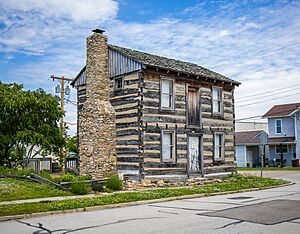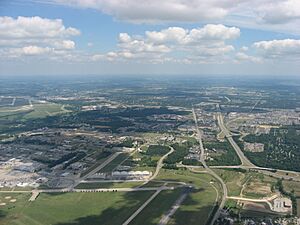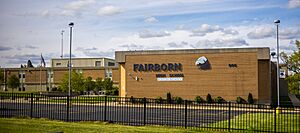Fairborn, Ohio facts for kids
Quick facts for kids
Fairborn, Ohio
|
|||
|---|---|---|---|
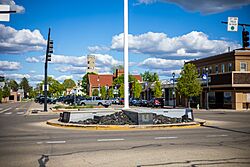
Downtown Fairborn
|
|||
|
|||
| Motto(s):
"A City in Motion"
|
|||
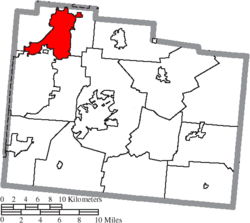
Location of Fairborn in Greene County
|
|||
| Country | United States | ||
| State | Ohio | ||
| County | Greene | ||
| Incorporated | 1950 | ||
| Area | |||
| • Total | 14.725 sq mi (37.77 km2) | ||
| • Land | 14.71 sq mi (37.74 km2) | ||
| • Water | 0.015 sq mi (0.03 km2) | ||
| Elevation | 840 ft (260 m) | ||
| Population
(2020)
|
|||
| • Total | 34,620 | ||
| • Estimate
(2023)
|
34,729 | ||
| • Density | 2,368.57/sq mi (914.50/km2) | ||
| Time zone | UTC-5 (Eastern (EST)) | ||
| • Summer (DST) | UTC-4 (Eastern (EDT)) | ||
| ZIP code |
45324
|
||
| Area code(s) | 937, 326 | ||
| FIPS code | 39-25914 | ||
| GNIS feature ID | 2394726 | ||
| Website | https://www.fairbornoh.gov | ||
Fairborn is a city in Greene County, Ohio, United States. In 2020, about 34,620 people lived there. It's a town near Dayton and is part of the larger Dayton area.
Fairborn is home to Wright State University, a big college with many students. The city also has a special training place called Calamityville. Here, people learn how to handle big emergencies and disasters.
Fairborn is the only city in the world with this name! Its name is a "portmanteau" (say: port-man-TOE), which means it's a word made by blending two other words. Fairborn was created from the names of two older towns: Fairfield and Osborn.
After a huge flood in 1913, the area built a dam to control the Mad River. People living in Osborn had to move their houses to a new spot next to Fairfield. In 1950, these two villages joined together to form the new city of Fairborn.
Contents
Fairborn's History: How the City Began
Fairborn was formed in 1950 when the villages of Fairfield and Osborn became one city. Fairfield was started by European settlers in 1816, and Osborn began in 1850.
Early Settlements and Names
The area where Fairfield was built was settled by European Americans even before Ohio became a state. The first log cabin was built in 1799 by George Greiner. Pioneers from Kentucky and Virginia liked this area near the Mad River for its good land.
However, this was also the land of the native Shawnee people. Sometimes, the Shawnee would raid the village, and settlers would fight back. Both sides sometimes took prisoners, but there were no big battles where many people died.
There are two stories about how Fairfield got its name. One story says a Native American chief, possibly Shawnee, made peace with the settlers. He looked out from Reed's Hill and said, "Yonder lies a fair field. I see thousands of white men moving about in that beautiful fair field."
The other idea is that the town was named after a place called Fairfield in England.
Nearby Osborn was named after E.F. Osborn, a railroad boss. Fairfield had said no to having the railroad built through their town. So, the railroad went through Osborn instead. Many of the first houses from old Osborn were moved to Fairborn's Historic Osborn District in the early 1920s.
Growth and Changes in Fairborn
From 1950 to 1970, Fairborn grew a lot, becoming six times bigger! It even became the most populated city in the county, passing Xenia. This growth happened mostly because of the nearby Wright-Patterson Air Force Base.
Another big employer was Southwestern Portland Cement, which had the largest factory in the city.
Until the mid-1960s, Fairborn had rules that stopped African Americans from living there. This was called a "sundown town." Leaders at Wright-Patterson Air Force Base helped the city change these rules, especially after the United States military became integrated in 1948.
Construction of Interstate 675 started in the 1960s. This highway was meant to go around Dayton on the east side. The first part of I-675 was built just east of Fairborn in the early 1970s. For over ten years, no more of the highway was built. Some people joked it was "Fairborn's private Interstate." The highway was finally finished in 1987.
Fairborn's growth slowed down in the 1970s. But it has started growing again at a steady pace since the late 1980s. Now, a nearby city called Beavercreek has more people than Fairborn.
Fairborn Today
In 2007, many people in Fairborn still worked at Wright-Patterson Air Force Base. This base is very important and is one of the biggest and most complex bases for the Air Force.
Many people also work at or go to Wright State University. This university became its own school in 1967. It started with just a few buildings but has grown into a large campus with many students. Even though Wright State has a Dayton address, it is actually inside Fairborn's city limits. Wright State University has its own police officers who are officially sworn in by the State of Ohio.
Fairborn is home to the largest elementary school in Ohio, Fairborn Primary School. Students there include children of military families assigned to the Air Force base.
Fairborn hosts fun events every year. There's an annual Sweet Corn Festival in August and the USAF marathon in September. The city also has a 4th of July Parade to celebrate.
Fairborn's Location and Size
Fairborn is about 14.7 square miles (37.8 square kilometers) in total size. Most of this area is land, with only a very small part being water. About 8.8 square miles (22.9 square kilometers) of the land is used for homes. The rest is for businesses, farms, or factories.
People of Fairborn: Population and Diversity
| Historical population | |||
|---|---|---|---|
| Census | Pop. | %± | |
| 1950 | 7,847 | — | |
| 1960 | 19,453 | 147.9% | |
| 1970 | 32,267 | 65.9% | |
| 1980 | 29,747 | −7.8% | |
| 1990 | 31,300 | 5.2% | |
| 2000 | 32,052 | 2.4% | |
| 2010 | 32,770 | 2.2% | |
| 2020 | 34,510 | 5.3% | |
| 2023 (est.) | 34,729 | 6.0% | |
| Sources: | |||
Fairborn's Population in 2020
In 2020, there were 34,510 people living in Fairborn. There were 14,931 households, which are groups of people living together. The city had about 2,368 people per square mile.
Most people in Fairborn are White (81.8%). There are also African American people (8.7%), Asian people (2.4%), and Native American people (0.1%). About 6.4% of people were from two or more races. People who are Hispanic or Latino made up 3.9% of the population.
About 26% of households had children under 18. Many households (36.1%) were married couples. The average household had 2.20 people.
The average age in Fairborn was 34.4 years old. About 18.9% of residents were under 18. About 18.3% of the population lived below the poverty line.
Fairborn's Economy: Jobs and Income
Fairborn has many different employers. Here are some of the top ones from 2021:
| # | Employer | # of Employees |
|---|---|---|
| 1 | Wright State University | 2,300 |
| 2 | Morris Home Furnishings | 443 |
| 3 | Peerless Technologies | 300 |
| 4 | Ali Industries | 282 |
| 5 | Kroger Co. | 206 |
| 6 | I-Supply | 173 |
| 7 | Ball Aerospace | 126 |
| 8 | The Design Knowledge Company | 70 |
The city of Fairborn collects a 2.0% income tax. There is also a small 0.5% tax that helps support the local schools.
Parks and Fun Places in Fairborn
Fairborn has a lot of green spaces! The city's Parks & Recreation team takes care of over 773 acres of parks, nature preserves, and cemeteries.
Greene County Parks and Trails also manages two nature preserves in Fairborn, covering 242 acres. Plus, a group called the Beaver Creek Wetlands Association looks after another 130-acre nature preserve.
In total, over 1,145 acres of Fairborn's land are parks, nature preserves, or cemeteries. That's a lot of space to explore!
Here are some of the parks and natural areas in Fairborn:
|
|
Education in Fairborn: Schools and Colleges
Fairborn has several schools for students of all ages.
Public Schools
- Fairborn Primary School: For students in pre-kindergarten through 2nd grade.
- Fairborn Intermediate School: For students in 3rd through 5th grade.
- Fairborn Baker Middle School: For students in 6th through 8th grade.
- Fairborn High School: For students in 9th through 12th grade.
Private Schools
- Bethlehem Lutheran School: A private school for students in pre-kindergarten through 8th grade.
Colleges and Universities
- Wright State University: A public university where students can earn bachelor's and master's degrees. It has over 19,000 students.
- Air Force Institute of Technology: A special university located on Wright-Patterson Air Force Base. It's mostly for military members and Department of Defense workers.
Fairborn also has a branch of the Greene County Public Library, where you can find books and learn new things.
Famous People from Fairborn
Many interesting people have connections to Fairborn, including:
- Brian Billick — A famous football coach who led the Baltimore Ravens.
- Roger B. Chaffee — An astronaut who was part of the Apollo 1 mission.
- Gus Grissom — Another astronaut who was part of the Apollo 1 mission.
- Colonel Gregory H. Johnson — A NASA astronaut.
- Martha Masters — A talented classical guitarist.
- Buddy Miller — A musician, singer, and producer.
- Michael J. Saylor — The person who started the company MicroStrategy.
- Mark Turner — A jazz saxophonist and teacher.
- Jackie (Waddell) Warner — An actress known for the reality TV show Work Out.
See also
 In Spanish: Fairborn (Ohio) para niños
In Spanish: Fairborn (Ohio) para niños






